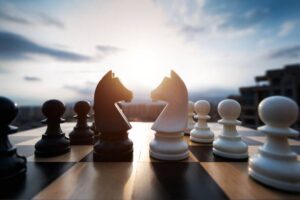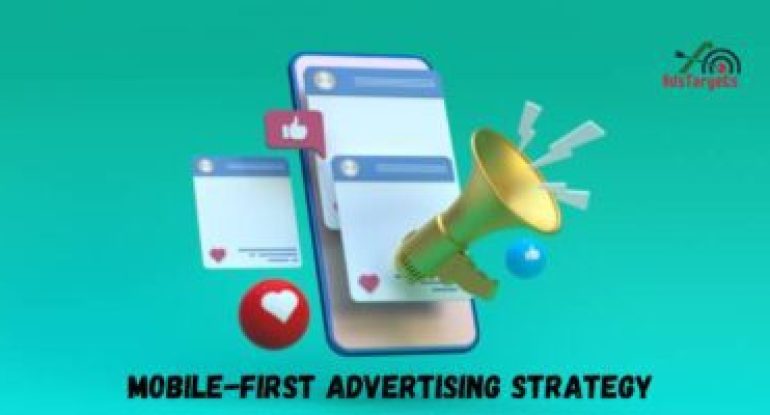Updated 13/04/2025
The mobile-first advertising strategy isn’t just a buzzword—it’s dominating the digital ad space. With global mobile ad spending hitting a massive $327 billion in 2022, it’s clear that brands are putting their money where the users are. And honestly, they should!
By 2023, a staggering 94% of internet users were scrolling, searching, and shopping via smartphones. That means if your ads aren’t optimized for mobile, you’re practically leaving money on the table.
But here’s the kicker—mobile-first advertising strategy isn’t just about keeping up with trends; it’s about adapting to consumer behavior, especially in the B2C market. Mobile users expect fast-loading, visually appealing, and interactive ad experiences that seamlessly fit into their browsing habits.
In this blog, we’re diving deep into everything you need to know—from best practices to pro tips—to ensure your brand nails its mobile ad game. Ready to level up? Let’s get into it.
Table of Contents
ToggleWhat’s Mobile-First Advertising?

A mobile-first advertising strategy is more than just resizing ads to fit a smartphone screen—it’s about putting mobile users at the heart of your marketing game plan.
In today’s digital world, people aren’t just occasionally using their phones—they practically live on them. From scrolling social feeds to binge-watching videos and impulse-buying at 2 AM, mobile behavior is fast, interactive, and deeply ingrained in daily life.
That’s why a mobile-first advertising strategy isn’t just an afterthought—it’s a must-have. It means designing ads that flow seamlessly into the mobile experience, keeping them engaging, quick to load, and easy to interact with.
Brands that get this right don’t just reach their audience—they connect with them. Whether it’s through snappy video ads, interactive experiences, or mobile-friendly CTAs, businesses that prioritize mobile are the ones that stay ahead of the competition in today’s fast-paced digital world.
Benefits of Mobile-First Advertising Matters

Mobile advertising is now a must for businesses aiming to succeed in the B2C space.
Here are some key benefits backed by industry insights and best practices:
#1. Wider Reach, Anytime, Anywhere
A mobile-first advertising strategy is your golden ticket to reaching more people, more often. Think about it—smartphones are practically glued to our hands. Whether people are commuting, chilling at home, or waiting in line for coffee, they’re scrolling, searching, and engaging with content.
That’s where mobile-first advertising strategy shines. It meets consumers where they already are—on their phones—ensuring your brand stays in their line of sight. With mobile ads, you’re not limited to desktops or specific locations. You can tap into a global audience 24/7, breaking barriers and boosting engagement in ways traditional ads just can’t.
Plus, mobile access means real-time opportunities. You can catch users in the moment—whether they’re hunting for a deal, researching a product, or just killing time. If your ads are built for mobile, they load fast, look great, and drive action without annoying friction.
Long story short? If you’re not prioritizing mobile, you’re missing out on massive visibility and engagement. Time to go all in on mobile-first.
#2. Next-Level Engagement & Interaction
A mobile-first advertising strategy isn’t just about reaching people—it’s about keeping them hooked. And guess what? Mobile users are way more likely to tap, swipe, and interact compared to desktop users.
Why? Because mobile is personal. It’s always within reach, and people naturally engage with content on their phones. Whether it’s scroll-stopping video ads, interactive polls, shoppable posts, or gamified experiences, mobile-first ads pull users in and make them part of the experience—not just passive viewers.
And let’s not forget about short-form video dominance. Platforms like TikTok, Instagram Reels, and YouTube Shorts are prime real estate for a killer mobile-first advertising strategy. If your ads are dynamic, engaging, and optimized for mobile, you’re not just grabbing attention—you’re driving action.
Bottom line? If you want higher engagement, more clicks, and better conversions, ditch the static, boring ads and go all-in on mobile-first interactivity.
#3. Boost Your ROI with Mobile-First Ads
When it comes to getting the most bang for your buck, mobile-first advertising strategy is where it’s at. Not only is it more cost-effective, but it’s also way more efficient in targeting specific audiences. You’re not just throwing ads out there hoping they stick. Nope, you’re using data-driven insights to reach exactly who you want—whether that’s based on location, age, interests, or browsing behavior.
Because mobile-first ads target the right people at the right time, you get a much higher return on investment (ROI) than with traditional advertising. Plus, you’re not wasting money on broad, generic audiences. Every dollar counts.
The beauty of this approach is that it’s all about optimization. You can tweak your ad spend based on performance in real time. So if something’s working, you can double down. If not, cut your losses fast and shift gears.
Long story short? A mobile-first advertising strategy makes your budget work harder for you. You’ll spend smarter, reach your audience more precisely, and see better ROI—without blowing through your ad spend.
#4. ` Personalization and Targeting
A mobile-first advertising strategy lets you deliver hyper-personalized ads based on user behavior, preferences, and interests. Instead of generic, one-size-fits-all campaigns, you can create highly targeted messages that feel natural and relevant to your audience.
With advanced targeting and retargeting, you’re not just hoping your ad lands in front of the right people—you’re ensuring it does. Whether it’s location-based promotions, dynamic content, or behavior-driven recommendations, personalization enhances engagement, conversions, and brand trust.
By making personalization a priority in your mobile-first advertising strategy, you’re giving users the kind of tailored experience they expect—boosting both your ROI and customer loyalty.
#5. Seamless User Experience
If your ads feel clunky, slow, or intrusive, users will bounce faster than you can say “missed opportunity.” A mobile-first advertising strategy isn’t just about showing up on mobile—it’s about making sure the experience is smooth, engaging, and frustration-free.
Optimized, mobile-friendly ads mean faster load times, clean layouts, and intuitive navigation. No one wants to pinch, zoom, or struggle to close an ad that takes over their screen. A well-designed ad experience keeps users engaged, increases conversions, and leaves a lasting positive impression.
By prioritizing a seamless user experience in your mobile-first advertising strategy, you’re not just running ads—you’re building relationships, enhancing brand trust, and driving long-term success in the digital space.
What are the Strategies for Effective Mobile-First Advertising?

#1. Less Text, More Visuals
When it comes to mobile-first advertising, simplicity is key. Google loves AMP pages (accelerated mobile pages) because they’re quick, clean, and user-friendly. These pages pack minimal text, big fonts, and eye-catching images that load in a flash—helping your site rank higher in search results.
And hey, Facebook’s on the same page. They don’t allow boosted posts with too much text either, so focus on visuals that are easy to digest and keep your conversion goals straightforward. It’s all about delivering a slick, mobile-optimized experience that catches the eye and gets results.
In short, in a mobile-first advertising strategy, visual appeal is a must. Keep things clean, direct, and easy to navigate, and you’ll be setting yourself up for success in the fast-paced mobile world.
#2. Responsive Design & Mobile-Friendly Content
A responsive design is your secret weapon when it comes to nailing a mobile-first advertising strategy. It ensures your website looks flawless on any screen size, so no matter what device users are on, they get the full experience. It’s like creating a seamless, visual journey from desktop to mobile, keeping them hooked.
But it doesn’t stop there. Mobile-friendly content is just as important. You’re not just throwing up a few words and hoping for the best—think visuals, punchy copy, and easy navigation that make the user feel like they’re in control. This creates an engaging experience that makes people stick around longer and engage with your ads.
Plus, Google loves mobile-friendly sites, which means you’ll get a little extra love when it comes to search rankings. And who doesn’t want that edge in today’s competitive digital landscape?
In the end, responsive design and mobile-friendly content go hand in hand to boost engagement, strengthen your brand and build lasting trust with your audience. So, if you’re all in on mobile-first advertising, this is the way to roll.
#3. Make the First Three Seconds Count in Your Mobile-First Advertising Strategy
In the world of mobile, where attention spans are shorter than ever, you’ve got literally three seconds to grab someone’s attention—max. Kieley Taylor of Catalyst puts it perfectly: If your ad doesn’t make an impact in the first three seconds, your chances of keeping someone around for 30+ seconds (let alone converting them) drop dramatically. That’s a lot of missed opportunity.
So, how do you make those first three seconds work in your favor? It’s all about creating quick, eye-catching messages that get straight to the point. Whether it’s a bold visual, an attention-grabbing headline, or an engaging hook, mobile-first advertising strategy needs to capitalize on those precious seconds to make an immediate impression.
To make the most of it, keep your message simple but compelling—the fewer the words, the better. People scroll fast, so don’t let them pass by your ad without it popping.
At the end of the day, maximizing the first three seconds of your ad is key to making sure your mobile-first strategy delivers results. Your goal? Hook them fast, keep them intrigued, and make them take action
#4. Consider the Context of Your Mobile-First Advertising Strategy
Let’s face it, today’s digital ad landscape is far from the old “one-size-fits-all” approach. With mobile-first advertising strategy in full swing, it’s more important than ever to factor in where and how people are interacting with your ads. Kevin Planovsky from Vert puts it simply: Your audience is everywhere—from people checking their phones during their commute to those squeezing in a scroll while on the toilet (yes, seriously!). Your ad spend should reflect this.
Gone are the days of just sending generic ads to everyone and hoping for the best. You’ve got to think strategically about location and context. Someone browsing your ad while at work might respond differently than someone just chilling at home. Tailoring your mobile-first advertising strategy to match the moment and mindset of your audience? That’s how you’ll really start connecting and converting.
#5. Educate Yourself on Your Digital Ad Options
In a world flooded with digital ads, it’s easy to feel overwhelmed by all the choices. Sean Allen from Twelve Three Media points out that understanding your options is crucial. If you rely on vendors to make all the decisions, you might miss out on some killer opportunities. Instead, take time to dive into the available ad formats and test them out yourself. The more you know, the better your strategy will be.
Social media targeting? That’s probably the most accurate targeting tool out there right now. As Google and Facebook continue to dominate, learning to leverage those platforms effectively could make or break your mobile-first advertising strategy. So, educate yourself, experiment, and see what works best for your brand.
#6. Focus on Video Content for Your Mobile Ads

If you’re not already incorporating video into your ads, now’s the time to jump on that train. Radomir Basta from Four Dots says it best: Video is taking over—and it’s happening fast. Whether it’s YouTube or your social media feeds, everyone’s watching videos on their mobile devices, and that’s not going to slow down anytime soon.
So, when building your mobile-first advertising strategy, make sure you’re optimizing your content for video. Think short, engaging, and mobile-friendly. Whether it’s a product demo, a tutorial, or an entertaining clip, video can boost engagement and capture attention like no other format.
#7. Review Your Google Analytics to Refine Your Strategy
One of the first things any advertiser should do is take a deep dive into their Google Analytics. Laura Cole from Vivial suggests that understanding where your traffic is coming from is key to refining your mobile-first advertising strategy. Are your users coming from social media? Organic search? Industry-specific websites?
From there, you can pinpoint which channels to target more effectively. For instance, you may want to invest more in social ads, ramp up Google AdWords, or partner with industry websites for sponsored content. Whatever the approach, by reviewing your data, you can make sure your ad dollars are going towards the channels that actually bring in results.
TL;DR: Mobile-first advertising strategy is all about adapting to the mobile lifestyle, learning your options, and creating experiences that are relevant, engaging, and easy to digest. Consider your audience’s context, educate yourself on digital ad options, and optimize for video to keep up with the trends. Lastly, analyze your Google Analytics to ensure you’re targeting the right channels for the best ROI.
# 8. Let Social Lead the Charge in Your Mobile-First Advertising Strategy
Social media is basically the king of the mobile world right now, so it’s no surprise that it’s the best place to kick off your mobile-first advertising strategy. Verena Thompson from Conill points out that so much of what we do online happens on mobile, and if you’re not thinking mobile-first, you’re missing out. This means taking into account things like the format—is your content vertical or horizontal? Vertical reigns on mobile, so be sure to design accordingly. And it’s not just about the format; think about what mobile offers in terms of cool innovations, like Facebook 360 videos. You want to make use of these features to wow your audience.
One key point? Front-load your message—especially in videos longer than 12 seconds. Most people won’t stick around if you’re not catching their attention quickly, so make sure your mobile-first advertising strategy has the message up front and center to hook them from the get-go.
#9. Speed Is Key in a Mobile-First World
Let’s be real, nobody has time for slow-loading websites, especially on mobile. Peter Boyd from PaperStreet Web Design nails it when he says that speed is non-negotiable. Users on mobile devices often have limited bandwidth, and more importantly, they have limited patience. A slow site? Forget it. If you’re still struggling with a site that takes forever to load, especially if JavaScript is dragging it down, it’s time for a major upgrade.
And while you’re at it, remember to prioritize your content. Put the most important stuff right up front, so users don’t have to dig around to find what they need. The quicker they get what they’re after, the happier they’ll be—and the better your mobile-first advertising strategy will perform.
#10. Follow the Platform’s Best Practices
If you’re running ads on platforms like Facebook, Instagram, or even TikTok, each one has its own vibe and best practices. Johnny Wong from Operam emphasizes the importance of optimizing content for both the platform and mobile. If you’re creating a Facebook video ad, for example, grab attention in those first three seconds. Seriously, make it pop. Everyone’s scrolling through a busy feed, and you’ve got only a few moments to catch their eye before they’re off to the next thing.
And let’s not forget about video format—vertical videos are a must for mobile-first advertising strategies. People scroll vertically, so if your video’s in a horizontal format, you’re just making it harder for them to engage. Oh, and remember, most mobile users watch videos without sound. That means your message needs to speak for itself, even without the audio. Subtitles, visuals, and quick, impactful moments are your best friends here.
#11. Adapt to the New Mobile Experience
Mobile is more than just a smaller screen—it’s a whole new experience. Consumers are no longer just browsing—they’re looking for products, events, and spaces that fit their location and timing. This is why your mobile-first advertising strategy needs to be context-aware. Dava Guthmiller nails it when she says that we’re no longer living in a world of banner ads. Those old-school formats just don’t work the same way on mobile. Today, it’s all about creating experiences that are contextual, interactive, and social.
So instead of just pushing ads out there, focus on building experiences that align with the mobile user’s context. Is someone out and about, searching for a restaurant nearby? Target them with location-based ads that feel natural and helpful. The goal is to blend seamlessly with the user’s environment and make your ad feel less like a disruption and more like a valuable interaction.
TL;DR: Your mobile-first advertising strategy needs to be social-first, fast, and context-aware. Optimize your content for mobile formats, follow platform best practices, and prioritize user experience. Don’t forget—mobile isn’t just about fitting content onto a smaller screen; it’s about creating meaningful, location-based experiences that resonate with users. Keep it real, keep it relevant, and watch your engagement soar.
#. 12. Get to Know Your Mobile Customer Inside Out
To nail your mobile-first advertising strategy, you’ve gotta understand your audience at a deeper level. It’s not just about pushing products out there, it’s about figuring out what makes these mobile users tick. Bernadette Coleman from Advice Local says it best—really dive into their behaviors and habits. What gets them searching on their phone? What makes them pull the trigger on a purchase? It’s all about identifying those key moments of need—when people grab their phone and start Googling. Once you’ve got a grip on that, you can create a rock-solid strategy to hit them exactly when they’re looking for what you’ve got.
And don’t forget, mobile users are on the move—so your strategy needs to be adaptable and ready for those impulse moments. Mobile is quick, it’s all about speed and convenience. Your goal? Be there in those split-second decisions, making your brand their go-to when they need something right now.
#13. Location is Everything: Understanding Mobile User Contexts
When you’re thinking mobile-first advertising, location is huge. Gyi Tsakalakis from AttorneySync really drives this point home—mobile users often have completely different needs than desktop users. Their intent is shaped by where they are and what they’re doing at that moment. It’s not just about selling something; it’s about understanding the context. Are they out in the rain looking for an umbrella? Are they passing by your store and wondering if they should pop in? Mobile marketing is all about contextual targeting—think geo-fencing, weather targeting, even time-of-day targeting.
If you can tap into these little moments, your message will be way more relevant. And that’s when your mobile-first advertising strategy will really shine. Not only are you reaching people on their terms, but you’re doing it in a way that feels like you’re right there with them, understanding what they need, exactly when they need it.
#14. Shift From Apps To Mobile Web And Messaging
Forget the old-school obsession with apps. The app world is getting crowded, and honestly, it’s not always worth investing your time. Matthew Jonas from TopFire Media points out that the app graveyard is real, with app installs growing at a slow crawl—just 6% in 2016. Instead, focus on the mobile web and messaging. These are the spaces where people are highly engaged and where you can reach them more directly. But remember, these platforms are personal—people don’t want to feel like you’re intruding in their space. If your message isn’t tailored and respectful of that personal connection, they might just bounce.
So, if you’re building a mobile-first advertising strategy, keep the focus on messaging that fits the platform. Think SMS, WhatsApp, and mobile web ads that feel organic and don’t cross that personal boundary. People are way more likely to engage with you if you respect the channel they’re on and offer them something valuable instead of just pushing ads in their face.
#15. Keep an Eye on Mobile Visitor Behavior

If you’re spending serious money driving traffic to your site, Todd Earwood from MoneyPath Marketing brings up an essential point: track your visitors—especially the mobile ones. Google’s already told us that mobile sites are getting preference in rankings, so your site has to be mobile-friendly. But it’s not just about loading fast; it’s about making sure that once users land on your site, they’re getting the experience they’re expecting. How are your mobile users interacting with your site? Are they bouncing right off, or are they sticking around and converting?
If you notice a big gap between your mobile and desktop visitors—it’s time to rethink your strategy. Track conversion rates and optimize based on what you see. The mobile user’s behavior is going to be different, and your mobile-first advertising strategy needs to cater to that. Get real-time data on how they’re browsing and purchasing, and make sure your site and content are tailored to that mobile experience.
#16. Mobile Search and Voice Search Optimization
Okay, let’s talk about mobile search and voice search. These days, everyone’s glued to their phones, right? People use them for everything from shopping to researching the latest trends, and guess what? Mobile and voice searches are totally crushing desktop search. If you’re not optimizing for mobile-first, you’re definitely missing out. A mobile-first advertising strategy is no longer just a bonus—it’s a must. But how do you jump on this bandwagon? Let’s break it down.
First Things First: Mobile Experience is Everything
When it comes to mobile search optimization, it’s all about making sure users have an effortless experience. We’re talking fast loading times, easy navigation, and, of course, a design that doesn’t make users want to throw their phones out the window. Think mobile-first advertising strategy here. Your website needs to be mobile-friendly—and I don’t mean just looking decent on a small screen. We’re talking optimized for mobile. If your site’s loading slower than a snail, expect users to bounce faster than you can say “conversion rate.”
Make sure that when someone lands on your site, they can get what they need quickly—especially since people are more impatient than ever. If they’re searching for something specific on their phone, they want answers now. This isn’t about waiting for fancy graphics or animations to load. They want to know how to buy, where to get it, and what to do next—and they want that info right away. So, speed is your best friend here.
Get Chatty: Voice Search is Here to Stay
Now, let’s talk voice search. We all know how many people are asking Siri or Google Assistant for everything under the sun—whether they’re looking for a place to eat or trying to figure out how much pizza costs at 2 AM. So, it’s time to optimize for conversational content. Voice searches are casual and conversational—they’re like chatting with a friend, not typing out some stiff search term.
A voice search query typically looks like this: “Where’s the nearest coffee shop?” versus “coffee shop near me.” See the difference? That’s where you need to adjust your content to match the way people actually speak. If you nail this, you’re golden. And guess what? This boosts engagement like nobody’s business, because people love finding answers that feel like a natural conversation.
Local SEO is Key (If You’re a Business with a Physical Location)
If your business has a physical location, local SEO is critical—especially for mobile and voice searches. You know the drill: people ask things like “Where’s the nearest gym?” or “Find me a restaurant with vegan options nearby.” Those are location-based queries. So, make sure your content is set up to address local intent. Claim your Google My Business profile, and make sure your NAP (Name, Address, Phone number) is consistent across the web.
Even better, go ahead and adapt your content to answer the kinds of local questions people are asking in their voice searches. This makes it easier for them to find you when they’re in need of a quick solution. And if you’re continuously keeping tabs on what’s working and adjusting, your mobile-first advertising strategy will always stay ahead of the curve.
The thing about mobile and voice search is that it’s always changing. New trends, new technologies, new ways people ask questions. To stay on top, you’ve got to keep monitoring your traffic and tweaking your strategy to match evolving user behavior. Adaptation is key. And the more you fine-tune, the better your conversions and engagement rates will be. It’s not a “set it and forget it” thing. You’ve got to stay agile and ready to pounce when new opportunities pop up.
Conclusion
So here’s the deal—mobile-first advertising strategy isn’t just about making your website work on a phone. It’s about creating an experience that’s fast, easy, and relevant. Get cozy with conversational content for voice search, especially if you’re targeting local customers. And keep an eye on your analytics—because the only thing constant in the mobile world is change. The more you adapt, the more you’ll connect with your audience, and the better your results will be. So go ahead, get that strategy locked down, and watch your mobile game go through the roof.
To crush your mobile-first advertising strategy, dig deep into what drives mobile users—when they search, where they are, and how they engage. Location and context matter a lot, so use those insights to craft targeted, relevant messages. Ditch the outdated app obsession and focus on mobile web and messaging. And always keep an eye on how your mobile visitors are behaving on your site—track everything, learn from it, and adapt. If you can nail these aspects, your strategy will be on point, and your engagement will go through the roof.








